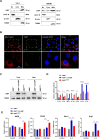Mitochondrial apolipoprotein A-I binding protein alleviates atherosclerosis by regulating mitophagy and macrophage polarization
- PMID: 35525979
- PMCID: PMC9077873
- DOI: 10.1186/s12964-022-00858-8
Mitochondrial apolipoprotein A-I binding protein alleviates atherosclerosis by regulating mitophagy and macrophage polarization
Abstract
Apolipoprotein A-I binding protein (AIBP), a secreted protein, has been shown to play a pivotal role in the development of atherosclerosis. The function of intracellular AIBP, however, is not yet well characterized. Here, we found that AIBP is abundantly expressed within human and mouse atherosclerotic lesions and exhibits a distinct localization in the inner membrane of mitochondria in macrophages. Bone marrow-specific AIBP deficiency promotes the progression of atherosclerosis and increases macrophage infiltration and inflammation in low-density lipoprotein receptor-deficient (LDLR-/-) mice. Specifically, the lack of mitochondrial AIBP leads to mitochondrial metabolic disorders, thereby reducing the formation of mitophagy by promoting the cleavage of PTEN-induced putative kinase 1 (PINK1). With the reduction in mitochondrial autophagy, macrophages polarize to the M1 proinflammatory phenotype, which further promotes the development of atherosclerosis. Based on these results, mitochondrial AIBP in macrophages performs an antiatherosclerotic role by regulating of PINK1-dependent mitophagy and M1/M2 polarization. Video Abstract.
Keywords: AIBP; Atherosclerosis; Macrophage polarization; Mitophagy.
© 2022. The Author(s).
Conflict of interest statement
The authors declare that they have no competing interests.
Figures






Similar articles
-
Intracellular AIBP (Apolipoprotein A-I Binding Protein) Regulates Oxidized LDL (Low-Density Lipoprotein)-Induced Mitophagy in Macrophages.Arterioscler Thromb Vasc Biol. 2021 Feb;41(2):e82-e96. doi: 10.1161/ATVBAHA.120.315485. Epub 2020 Dec 24. Arterioscler Thromb Vasc Biol. 2021. PMID: 33356389 Free PMC article.
-
AIBP protects against metabolic abnormalities and atherosclerosis.J Lipid Res. 2018 May;59(5):854-863. doi: 10.1194/jlr.M083618. Epub 2018 Mar 20. J Lipid Res. 2018. PMID: 29559522 Free PMC article.
-
Low Fluoride Regulates Macrophage Polarization Through Mitochondrial Autophagy Mediated by PINK1/Parkin Axis.Biomolecules. 2025 Apr 30;15(5):647. doi: 10.3390/biom15050647. Biomolecules. 2025. PMID: 40427540 Free PMC article.
-
Regulation of lipid rafts, angiogenesis and inflammation by AIBP.Curr Opin Lipidol. 2019 Jun;30(3):218-223. doi: 10.1097/MOL.0000000000000596. Curr Opin Lipidol. 2019. PMID: 30985364 Free PMC article. Review.
-
The Role of PTEN-L in Modulating PINK1-Parkin-Mediated Mitophagy.Neurotox Res. 2022 Aug;40(4):1103-1114. doi: 10.1007/s12640-022-00475-w. Epub 2022 Jun 14. Neurotox Res. 2022. PMID: 35699891 Review.
Cited by
-
Macrophage polarization and its impact on idiopathic pulmonary fibrosis.Front Immunol. 2024 Jul 26;15:1444964. doi: 10.3389/fimmu.2024.1444964. eCollection 2024. Front Immunol. 2024. PMID: 39131154 Free PMC article. Review.
-
Mitochondria as novel mediators linking gut microbiota to atherosclerosis that is ameliorated by herbal medicine: A review.Front Pharmacol. 2023 Jan 17;14:1082817. doi: 10.3389/fphar.2023.1082817. eCollection 2023. Front Pharmacol. 2023. PMID: 36733506 Free PMC article. Review.
-
[Correlation of serum ferredoxin 1 and lipoic acid levels with severity of coronary artery disease].Nan Fang Yi Ke Da Xue Xue Bao. 2024 Feb 20;44(2):308-316. doi: 10.12122/j.issn.1673-4254.2024.02.13. Nan Fang Yi Ke Da Xue Xue Bao. 2024. PMID: 38501416 Free PMC article. Chinese.
-
The effect of intestinal flora metabolites on macrophage polarization.Heliyon. 2024 Aug 3;10(15):e35755. doi: 10.1016/j.heliyon.2024.e35755. eCollection 2024 Aug 15. Heliyon. 2024. PMID: 39170251 Free PMC article. Review.
-
Mitochondria-Targeted Biomaterials-Regulating Macrophage Polarization Opens New Perspectives for Disease Treatment.Int J Nanomedicine. 2025 Feb 4;20:1509-1528. doi: 10.2147/IJN.S505591. eCollection 2025. Int J Nanomedicine. 2025. PMID: 39925677 Free PMC article. Review.
References
-
- Atherosclerosis. Nat Rev Dis Primers 2019, 5: 57. - PubMed
-
- Yin K, Deng X, Mo ZC, et al. Tristetraprolin-dependent post-transcriptional regulation of inflammatory cytokine mRNA expression by apolipoprotein A-I: role of ATP-binding membrane cassette transporter A1 and signal transducer and activator of transcription 3. J Biol Chem. 2011;286:13834–13845. doi: 10.1074/jbc.M110.202275. - DOI - PMC - PubMed
Publication types
MeSH terms
Substances
LinkOut - more resources
Full Text Sources
Medical
Research Materials
Miscellaneous

